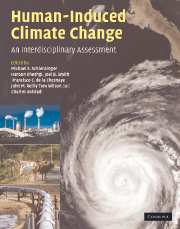Book contents
- Frontmatter
- Contents
- List of contributors
- Preface
- Part I Climate system science
- Part II Impacts and adaptation
- Part III Mitigation of greenhouse gases
- Part IV Policy design and decisionmaking under uncertainty
- 25 Climate policy design under uncertainty
- 26 Climate policy assessment using the Asia–Pacific Integrated Model
- 27 Price, quantity, and technology strategies for climate change policy
- 28 What is the economic value of information about climate thresholds?
- 29 Boiled frogs and path dependency in climate policy decisions
- 30 Article 2 and long-term climate stabilization: methods and models for decisionmaking under uncertainty
- 31 Whither integrated assessment? Reflections from the leading edge
- 32 Moving beyond concentrations: the challenge of limiting temperature change
- 33 International climate policy: approaches to policies and measures, and international coordination and cooperation
- Index
- Plate section
- References
27 - Price, quantity, and technology strategies for climate change policy
from Part IV - Policy design and decisionmaking under uncertainty
Published online by Cambridge University Press: 06 December 2010
- Frontmatter
- Contents
- List of contributors
- Preface
- Part I Climate system science
- Part II Impacts and adaptation
- Part III Mitigation of greenhouse gases
- Part IV Policy design and decisionmaking under uncertainty
- 25 Climate policy design under uncertainty
- 26 Climate policy assessment using the Asia–Pacific Integrated Model
- 27 Price, quantity, and technology strategies for climate change policy
- 28 What is the economic value of information about climate thresholds?
- 29 Boiled frogs and path dependency in climate policy decisions
- 30 Article 2 and long-term climate stabilization: methods and models for decisionmaking under uncertainty
- 31 Whither integrated assessment? Reflections from the leading edge
- 32 Moving beyond concentrations: the challenge of limiting temperature change
- 33 International climate policy: approaches to policies and measures, and international coordination and cooperation
- Index
- Plate section
- References
Summary
Introduction
Cost-effective market approaches to environmental management all entail the use of some form of price signal, and they can generally be grouped as quantity-based or tax-based regulations. The quantity-based approach, in the form of “cap-and-trade” programs, has gained an especial popularity in the past two decades. The political acceptance of cap-and-trade over the tax approach has its roots in a favorable set of political attributes (Hahn and Stavins, 1991) and a successful experience with the Title IV SO2 cap. Its support among economists comes from its theoretical capability to achieve any stated cap at minimum cost. Most importantly, it has been accepted by those with a greater concern for environmental outcomes than for program costs, because the idea of a cap provides certainty of particular emissions levels in return for uncertainty about the costs of achieving those emissions levels.
Cap-and-trade was such a popular policy prescription during the 1990s that almost the entire discussion about climate change policy during that time was cast in terms of how to design a greenhouse gas (GHG) trading program, and how to build international agreements and institutions that could allow emission trading to function even where caps could not be directly imposed. (Joint implementation and the extensive set of rules and procedures surrounding the Clean Development Mechanism are examples of the latter.
- Type
- Chapter
- Information
- Human-Induced Climate ChangeAn Interdisciplinary Assessment, pp. 328 - 342Publisher: Cambridge University PressPrint publication year: 2007
References
- 20
- Cited by



